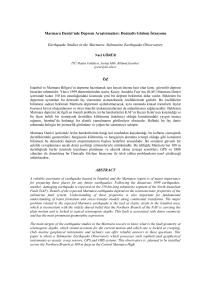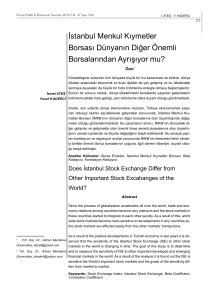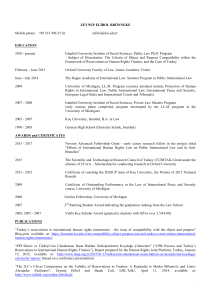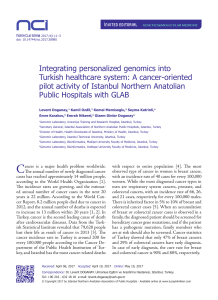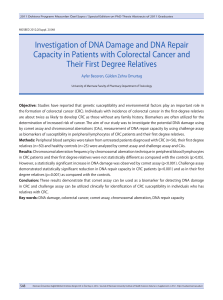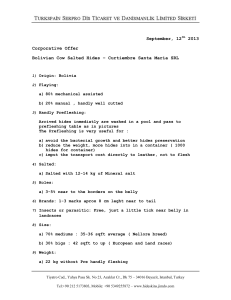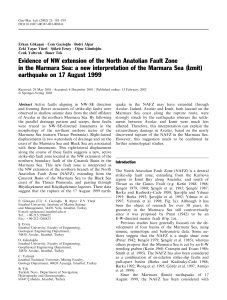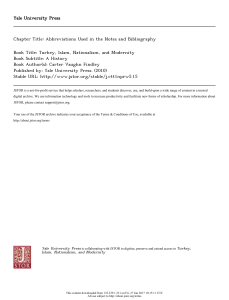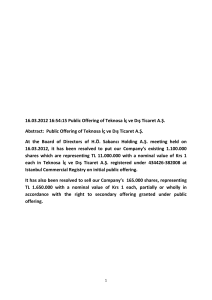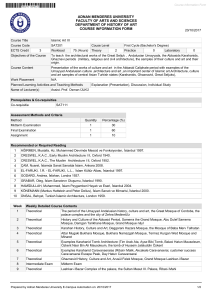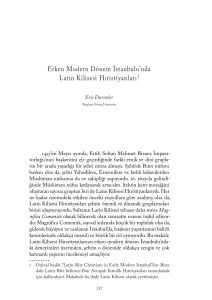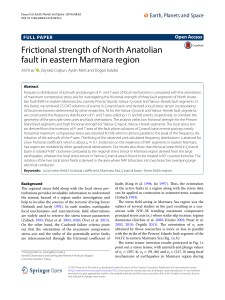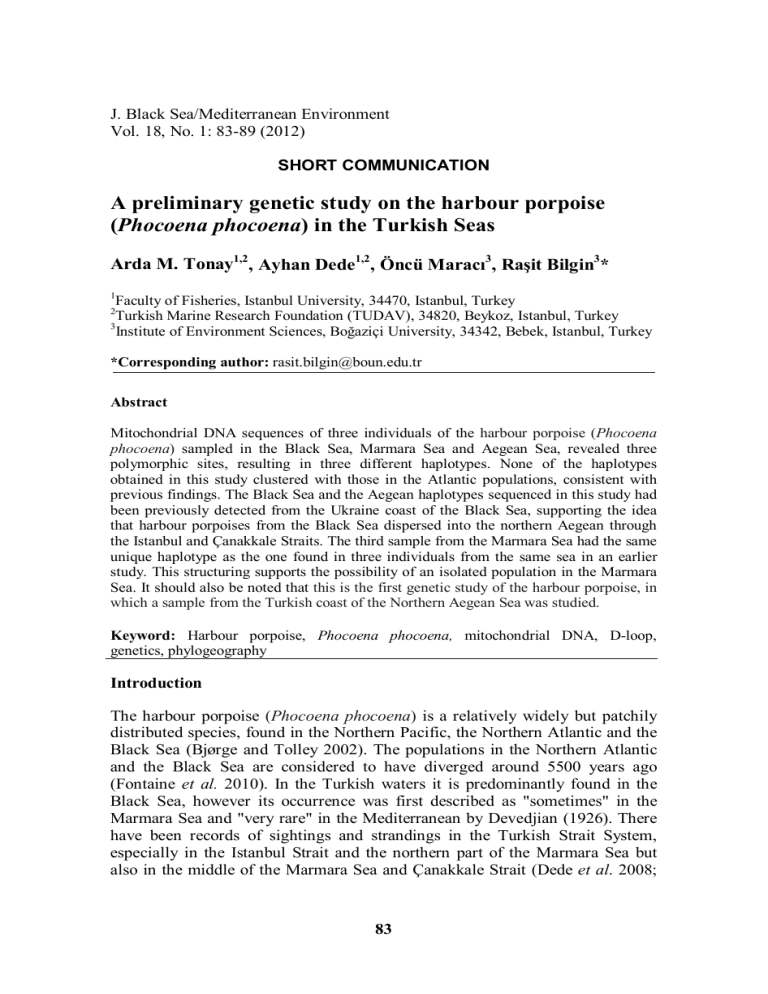
J. Black Sea/Mediterranean Environment
Vol. 18, No. 1: 83-89 (2012)
SHORT COMMUNICATION
A preliminary genetic study on the harbour porpoise
(Phocoena phocoena) in the Turkish Seas
Arda M. Tonay1,2, Ayhan Dede1,2, Öncü Maracı3, Raşit Bilgin3*
1
Faculty of Fisheries, Istanbul University, 34470, Istanbul, Turkey
Turkish Marine Research Foundation (TUDAV), 34820, Beykoz, Istanbul, Turkey
3
Institute of Environment Sciences, Boğaziçi University, 34342, Bebek, Istanbul, Turkey
2
*Corresponding author: [email protected]
Abstract
Mitochondrial DNA sequences of three individuals of the harbour porpoise (Phocoena
phocoena) sampled in the Black Sea, Marmara Sea and Aegean Sea, revealed three
polymorphic sites, resulting in three different haplotypes. None of the haplotypes
obtained in this study clustered with those in the Atlantic populations, consistent with
previous findings. The Black Sea and the Aegean haplotypes sequenced in this study had
been previously detected from the Ukraine coast of the Black Sea, supporting the idea
that harbour porpoises from the Black Sea dispersed into the northern Aegean through
the Istanbul and Çanakkale Straits. The third sample from the Marmara Sea had the same
unique haplotype as the one found in three individuals from the same sea in an earlier
study. This structuring supports the possibility of an isolated population in the Marmara
Sea. It should also be noted that this is the first genetic study of the harbour porpoise, in
which a sample from the Turkish coast of the Northern Aegean Sea was studied.
Keyword: Harbour porpoise, Phocoena phocoena, mitochondrial DNA, D-loop,
genetics, phylogeography
Introduction
The harbour porpoise (Phocoena phocoena) is a relatively widely but patchily
distributed species, found in the Northern Pacific, the Northern Atlantic and the
Black Sea (Bjørge and Tolley 2002). The populations in the Northern Atlantic
and the Black Sea are considered to have diverged around 5500 years ago
(Fontaine et al. 2010). In the Turkish waters it is predominantly found in the
Black Sea, however its occurrence was first described as "sometimes" in the
Marmara Sea and "very rare" in the Mediterranean by Devedjian (1926). There
have been records of sightings and strandings in the Turkish Strait System,
especially in the Istanbul Strait and the northern part of the Marmara Sea but
also in the middle of the Marmara Sea and Çanakkale Strait (Dede et al. 2008;
83
Ozturk et al. 2009; Tonay et al. 2009; Dede 2010). There are two records of
stranded harbour porpoises in the Turkish Aegean Sea coast; one was in Izmir
Bay (Güçlüsoy 2008) and the other in Saroz Bay (Tonay et al. 2009). Other than
these, at least nine records of strandings and sightings of harbour porpoises were
reported in the Greek Northern Aegean Sea since 1993 (Frantzis et al. 2003; Di
Sciara and Birkun 2010).
Morphological and genetic differences of Black Sea harbour porpoises were
well studied and resulted in the description of a subspecies, Phocoena phocoena
relicta (Rosel et al. 1995, 2003; Fontaine et al. 2007; 2010; Viaud-Martinez et
al. 2007; Galatius and Gol’din 2011). Genetic signature, and the age and small
size of the harbour porpoises found in the Greek coast of the Northern Aegean,
suggest that these individuals originated from the Black Sea (Rosel et al. 2003;
Viaud-Martinez et al. 2007). Although the Black Sea and Northern Aegean Sea
harbour porpoises have identical mtDNA sequences in the hypervariable control
region, suggesting connectivity, it is still possible that they may represent
separate subpopulations (Notarbartolo di Sciara and Birkun, 2010). In addition,
a private haplotype found in three individuals in the Marmara Sea suggest that
harbour porpoises in this water body may be genetically differentiated from both
the Black Sea and Northern Aegean Sea populations (Viaud-Martinez et al.
2007). In a subsequent study, Birkun (2008) suggested that the harbour porpoise
could be containing three or more subpopulations in the Black Sea and
neighbouring waters.
In this study three individuals of harbour porpoise were sampled from the
Aegean Sea, Black Sea and Marmara Sea and their mitochondrial D-loop was
partially sequenced. This is the first genetic study of harbour porpoise that
includes a sample from the Turkish coast of the Northern Aegean. Two samples
were of the individuals bycaught in Turkish Western Black Sea in 2007 (Tonay
2010) and the Marmara Sea in 2006 (Tonay et al. 2007) and the third one was
found stranded in Saroz Bay in the Northern Aegean coast of Turkey in 2007
(Tonay et al. 2009) (Figure1).
The samples were collected from skin tissues and preserved in 5% dimethyl
sulphoxide (DMSO) saturated with sodium chloride at 20 °C. DNA was
extracted using Roche High Pure PCR Template Preparation Kit (Indianapolis,
USA) following the manufacturer’s protocol. The two primers described by
Rosel et al. (1999), L15824 (5’-CCTCACTCCTC CCTAAGACT-3’) and
H16265 (5’-GCCCGGTGCGAGAAGAGG-3’) were used to amplify a partial
364 base pair-long mitochondrial DNA (mtDNA) fragment of the control
region. PCR reactions were performed in a 25 µl volume containing
approximately 20 ng genomic DNA, 2.5µl 10X Taq buffer, 2 mM of MgCl2, 0.4
mM of each primer, 0.8 mM deoxyribonucleotide triphosphate and 1 U Taq
DNA polymerase (Fermentas). The PCR program was as follows: an initial
denaturation step at 94°C for 2 minutes, followed by 35 cycles of 45 seconds at
84
94°C, 1 minute at 64 °C, 1 minute at 72°C, with a final extension step of 5
minutes at 72°C.
Figure 1. Study area. (Dots show harbour porpoise locations.)
The amplified fragments were purified with Roche High Pure PCR Product
Purification Kit (Indianapolis, USA), following the manufacturer’s instructions
and sequenced in both directions by Macrogen Inc. (South Korea), using the
L15824 and H16265 primers. Sequencing data was edited with Sequencher
v.3.1 (Gene Codes Corp.). To reveal evolutionary relationships among
haplotypes, statistical parsimony network analysis was performed using TCS
v.1.13 (Clement et al. 2000). Previously reported 31 sequences from the same
mitochondrial region (Viaud-Martinez et al. 2007) (GenBank accession
numbers EF063110, EF063646- EF063675, U09689-U09691) were also
included in this analysis. Investigation of 364 bp mtDNA sequences from three
harbour porpoises revealed three polymorphic sites in three different haplotypes,
differing from each other by two single base substitutions. Each of the
haplotypes obtained in our study matched to three different sequences reported
by Viaud-Martinez et al. (2007) (Figure 2). The haplotype of the Black Sea
sample (haplotype XV) had been previously detected on the Ukraine coast of
the Black Sea. The haplotype of the Aegean individual was found identical to
that of an individual found on the Ukrainian Black Sea coast (Haplotype XVI).
This finding supports the idea that harbour porpoises from the Black Sea
dispersed into the northern Aegean through the Istanbul and Çanakkale Straits
(Rosel et al. 2003).
85
86
This figure corrected on 5 April 2013.
Figure 2. Haplotype network for the mitochondrial control region. The sizes of the circles and squares are proportional
to the frequency of each haplotype. Circles represent the haplotypes identified by Viaud-Martinez et al. (2007). Squares
represent the haplotypes found in our study and by Viaud-Martinez et al. (2007). Black circles represent hypothetical
haplotypes. Each line between haplotypes represents a single mutational step between haplotypes.
Viaud-Martinez et al. (2007) had investigated three individuals sampled from
the Marmara Sea in different months and reported that all of them share a
unique haplotype (Haplotype XVIII), which was not observed in other
individuals from the Black Sea nor the Aegean Sea. The Marmara Sea sample
sequenced in this study had the same haplotype. This pattern supports the
possibility of an isolated population in the Marmara Sea, as suggested also by
Viaud-Martinez et al. (2007).
None of the haplotypes obtained in this study clustered with the Atlantic
populations consistent with the idea that Atlantic and Black Sea populations are
reproductively isolated and should be considered as subspecies (Phocoena
phocoena phocoena and Phocoena phocoena relicta, respectively) (Rosel et al.
1995). It will be necessary to carry out genetic research with more samples to
obtain a better understanding of the relationships of the subpopulations of
harbour porpoises especially in the Marmara Sea as well as those in the Black
Sea.
Acknowledgements
We would like to thank Evrim Kalkan for her help with the lab analyses, Emrah Çoraman
for helping with the production of the figures, and Dr. Ayaka Öztürk for her comments
on an earlier version of the manuscript. This study was supported by a grant (No: 6183)
from the Research Fund of Boğaziçi University in Istanbul to RB.
Türkiye Denizleri’nde yaşayan muturlar
(Phocoena phocoena) hakkında genetik bir ön çalışma
Özet
Karadeniz, Marmara Denizi ve Ege Denizi’nden üç tane muturun (Phocoena phocoena)
mitokondrial DNA analizi, üç farklı haplotipe tekabül eden üç polimorfik bölgenin
varlığını gösterdi. Önceki bulgularla örtüşen bir şekilde, bu çalışmada elde edilen
haplotiplerin hiçbiri Atlantik’ten olanlarla gruplaşmadı. Karadeniz ve Ege haplotiplerinin
daha önceden Ukrayna’nın Karadeniz kıyısında kaydedilmiş olanlarla aynı olması,
Karadeniz’deki muturların Ege’ye İstanbul ve Çanakkale Boğaları üzerinden geçtikleri
fikrini desteklemektedir. Marmara Denizi’nden olan üçüncü örnekte de, daha önceki bir
çalışmada yine aynı denizde üç bireyde tespit edilmiş olan benzersiz haplotip
bulunmuştur. Bu yapı Marmara Denizi’nde izole bir popülasyon olabileceği fikrini
desteklemektedir. Bu çalışmanın muturlarda Kuzey Ege’nin Türkiye kıyısından bir
örneğin genetik analizinin yapıldığı ilk çalışma olması da kayda değerdir.
References
Bjørge, A., Tolley, A.K. (2002) Harbor Porpoise Phocoena phocoena. In:
Encyclopedia of Marine Mammals. Academic Press, (eds., W.F. Perrin, B.
Würsig, J.G.M. Thewissen), USA, pp. 549-551.
87
Birkun, A.Jr. (2008) The state of Cetacean populations. In: Publication of the
Commission on the Protection of the Black Sea Against Pollution (BSC), (ed., T.
Oğuz), State of the Environment of the Black Sea (2001-2006/7). Istanbul,
Turkey, pp. 365-395.
Clement, M., Posada, D., Crandall, K.A. (2000) TCS: a computer program to
estimate gene genealogies. Molecular Ecology 9:1657–1659.
Dede, A. (2010) Marine mammals of the Marmara Sea. Proceedings of the
Symposium ‘The Marmara Sea 2010’ (ed., B. Ozturk) Turkish Marine Research
Foundation Publications no: 32, pp. 272-281 (in Turkish).
Dede, A., Ozturk, A.A., Tonay, A.M. (2008) Cetacean surveys in the Istanbul
(Bosphorus) Strait in 2006. In: Proceedings CD of 22nd Annual Conf. European
Cetacean Society, Egmond aan Zee, the Netherlands. (eds., G.J. Pierce, E.
Philips, R. Lick).
Devedjian, K. (1926) Pêche et Pêcheries en Turquie. Imprimerie de
l’Administration de la Dette Publique Ottomane, Istanbul, 480pp. (Translated by
Aras Yayıncılık 2006 Istanbul).
Fontaine, M.C., Baird, S.J.E., Piry, S., Ray, N., Tolley, K.A., Duke, S., Birkun,
A.Jr., Ferreira, M., Jauniaux, T., Llavona, A., Ozturk, B., Ozturk, A.A., Ridoux,
V., Rogan, E., Sequeira, M., Siebert, U., Vikingsson, G.A., Bouquegneau, J-M.,
Michaux, J.R. (2007) Rise of oceanographic barriers in continuous populations
of a Cetacean: the genetic structure of harbour porpoises in old world waters.
BMC Biology 5: 30.
Fontaine, M.C., Tolley, K.A., Michaux, J.R., Birkun, A.Jr., Ferreira, M.,
Jauniaux, T., Llavona, A., Ozturk, B., Ozturk, A.A., Ridoux, V., Rogan, E.,
Sequeira, M., Bouquegneau, J-M., Baird, S.J.E. (2010) Genetic genetic and
historic evidence for climate-driven population fragmentation in a top Cetacean
predator: the harbour porpoises in European Water. Proc. R. Soc. 277: 28292837.
Frantzis, A., Alexiadou, P., Paximadis, G., Politi, E., Gannier, A., Corsini-Foka,
M. (2003) Current knowledge of the cetacean fauna of the Greek Seas. J.
Cetacean Res. Manage. 5(3):219-232.
Galatius, A., Gol’din, P.E. (2011) Geographic variation of skeletal ontogeny and
skull shape in the harbour porpoise (Phocoena phocoena) Canadian Journal of
Zoology 89(9): 869-879.
88
Guclusoy, H. (2008) The first confirmed report of the harbour porpoise
(Phocoena phoceana) in the Turkish Aegean Sea. Marine Biodiversity Records,
1, e94 doi:10.1017/S1755267207009529.
Notarbartolo di Sciara, G., Birkun, A.Jr. (2010) Conserving Whales, Dolphins
and Porpoises in the Mediterranean and Black Seas. ACCOBAMS Status
Report, 2010, ACCOBAMS, Monaco, 212 pp.
Ozturk, A.A., Dede, A. Tonay, A.M., Ozturk, B. (2009) Cetacean surveys in the
Istanbul (Bosphorus) Strait in 2007-2008. In: Abstracts of 23rd Annual Conf.
European Cetacean Society, Istanbul, Turkey.
Rosel, P.E., Dizon, A.E., Haygood, M.G. (1995) Variability of the
mitochondrial control region in populations of the harbour porpoise, Phocoena,
on interoceanic and regional scales. Canadian Journal of Fisheries and Aquatic
Sciences 52(6): 1210-1219.
Rosel, P.E., Frantzis, A., Lockyer, C., Komnenou, A. (2003) Source of Aegean
Sea harbour porpoises. Mar. Ecol. Prog. Ser. 247: 257-261.
Rosel, P.E., Tiedemann, R., Walton, M. (1999) Genetic evidence for limited
trans-Atlantic movements of the harbour porpoise Phocoena phocoena. Marine
Biology 133: 583-591.
Tonay A.M. (2010) Interaction with the Cetacean strandings and turbot fisheries
in the western Black Sea. Ph.D Thesis. Istanbul University, the Institute of
Science. 117 pp (in Turkish).
Tonay, A. M., Dede, A., Ozturk, A.A. (2007) Stomach contents of bycaught
harbour porpoises (Phocoena phocoena) from the Marmara Sea. Rapp. Comm.
int. Mer Médit. 38: 617.
Tonay, A.M., Dede, A., Ozturk, A.A., Ozturk, B. (2009) Cetacean strandings in
the Turkish Straits System (TSS) and the Northern Aegean Sea coast of Turkey
during 1999-2008. In: Proc. 23rd Annual Conf. European Cetacean Society,
Istanbul, Turkey.
Viaud-Martinez, K.A., Milmer, M.V., Goldin, E.P., Ridoux, V., Ozturk, A.A.,
Ozturk, B., Rosel, P.E., Frantzis, A., Komnenou, A., Bohonak, A.J. (2007)
Morphological and genetic differentiation of the Black sea harbour porpoise
Phocoena phocoena. Marine Ecology Progress Series 338: 281-294.
Received: 02.12.2011
Accepted: 22.12.2011
89

